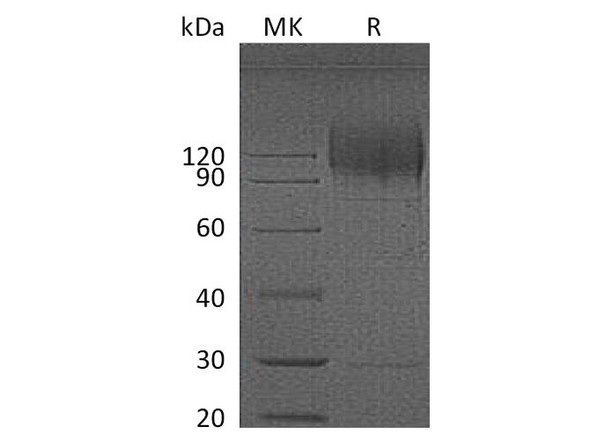Viral Recombinant Proteins
HIV-1 nef Recombinant Protein (RPPB5561)
- SKU:
- RPPB5561
- Product Type:
- Recombinant Protein
- Species:
- Viral
Description
| Product Name: | HIV-1 nef Recombinant Protein |
| Product Code: | RPPB5561 |
| Size: | 0.5mg |
| Species: | HIV-1 |
| Target: | nef |
| Source: | Escherichia Coli |
| Physical Appearance: | Sterile filtered colorless clear solution. |
| Formulation: | HIV-1 nef protein solution in 8M urea, 20mM Tris-HCl pH 8.0, 10mM b-mercaptoethanol. |
| Stability: | HIV-1 nef although stable at 4°C for 1 week, should be stored below -18°C. Please prevent freeze thaw cycles. |
| Purity: | Greater than 95.0% as determined by HPLC analysis and SDS-PAGE. |
| Amino Acid Sequence: | kwskssv igwptvrerm rraepaadgv gaasqdlekh gaitssntaa tnadcawleaqeeeevgfpv tpqvplrpmt ykaavdlshf lkekgglegl ihsqrrqdil dlwiyhtqgyfpdwqnytpg pgirypltfg wcyklvpvep ekleeankge ntsllhpvsl hgmddperevlewrfdsrla |
Human immunodeficiency virus (HIV) is a retrovirus that can lead to a condition in which the immune system begins to fail, leading to opportunistic infections. HIV primarily infects vital cells in the human immune system such as helper T cells (specifically CD4+ T cells), macrophages and dendritic cells. HIV infection leads to low levels of CD4+ T cells through three main mechanisms: firstly, direct viral killing of infected cells; secondly, increased rates of apoptosis in infected cells; and thirdly, killing of infected CD4+ T cells by CD8 cytotoxic lymphocytes that recognize infected cells. When CD4+ T cell numbers decline below a critical level, cell-mediated immunity is lost, and the body becomes progressively more susceptible to opportunistic infections. HIV was classified as a member of the genus Lentivirus, part of the family of Retroviridae. Lentiviruses have many common morphologies and biological properties. Many species are infected by lentiviruses, which are characteristically responsible for long-duration illnesses with a long incubation period. Lentiviruses are transmitted as single-stranded, positive-sense, enveloped RNA viruses. Upon entry of the target cell, the viral RNA genome is converted to double-stranded DNA by a virally encoded reverse transcriptase that is present in the virus particle. This viral DNA is then integrated into the cellular DNA by a virally encoded integrase so that the genome can be transcribed. Once the virus has infected the cell, two pathways are possible: either the virus becomes latent and the infected cell continues to function, or the virus becomes active and replicates, and a large number of virus particles are liberated that can then infect other cells.
The E.coli derived 20kDa recombinant protein genotype IIIB is a non-glycosylated polypeptide chain, containing the HIV-1 nef immunodominant regions, 3-190 amino acids. The HIV-1 nef is fused to beta-galactosidase (114 kDa) at the N-terminus.






